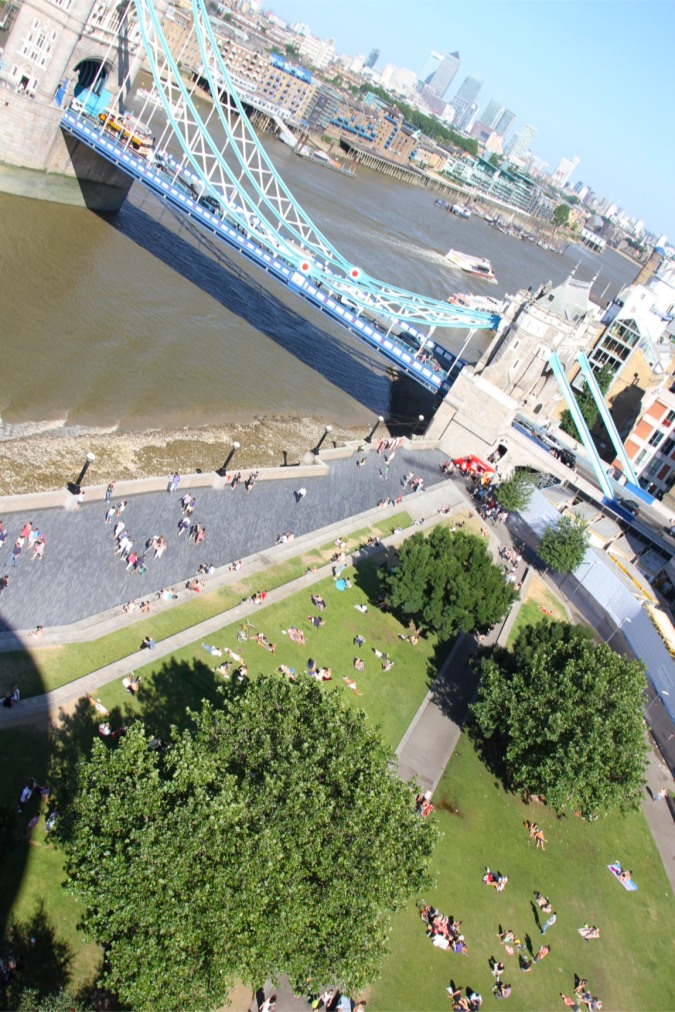Peter Ackroyd’s London, The Biography, is fascinating. One of his themes is London as ever changing, ever evolving, constantly being rebuilt on the ruins of London past. Retrospectively its possible to see this evolution – Roman and Medieval London can still be found in parts of today’s city. No one worried about ‘heritage’, things were just ripped down and rebuilt.
Every age – Anglo-Saxon, Norman, Tudor, Victorian, Georgian, right up until the shiny glass temples to international finance that currently dominate the skyline – has left its imprint on the ancient heart of the city. In the case of St. Helen’s and St. Andrew Undershaft (no sniggering), it is literally possible to see 12th century churches overshadowed by a building affectionately known as the ‘erotic gherkin’ – a giant phallus of glass and steel designed by Norman Foster (Freud would have had a field-day).

If there is a greater contrast in building style, purpose, materials and ethics anywhere in the world, I don’t know where it is. One truism, however, is that all these buildings are designed to inspire awe and wonder, and to communicate power.
Several new buildings have sprung up in the City of London recently (all have ridiculous names, the better to ingratiate themselves with the public): ‘The Cheese Grater’, ‘The Walkie-Talkie’ and ‘The Pinnacle’. ‘The Shard’, in Southwark, is the wrong side of the river to be part of the City. These buildings are transforming the cityscape, although, given London’s history, probably not forever.



It was with some trepidation that I entered another modern glass edifice, London City Hall, home to the Mayor of London and the London Assembly, to take the view from the top. Mayor Boris Johnson (a man many would accuse of having his own erotic gherkin) wasn’t at home, so it was possible to take the view unmolested…and, it has to be said, what a view.


Emerging onto the viewing platform, there was a giant crane somewhere in Southwark going about its business of changing the cityscape. Move anti-clockwise and Tower Bridge comes into focus, with views all the way to Canary Wharf. Then, directly over the River Thames, the Tower of London appears dwarfed by the modern city which has grown up around it. Move slightly to the west and the truly extraordinary sight of the City of London – a work in progress – is illuminated from on high.


The view is fabulous, its probably worth becoming Mayor for that reason alone. Its not just the view though. Despite the unfortunate nickname of ‘The Glass Gonad’ (bestowed upon the building by Mayor Boris), City Hall has been designed to surprise. It does have an unusual shape, more reminiscent of a motorbike helmet than a gonad, but inside it has a beautiful helix-shaped staircase similar to that of the Reichstag building in Berlin.


Descending this glass temple of temporal power, its possible to stroll under and then over Tower Bridge – possibly London’s most famous landmark – before arriving on the north bank of the River Thames where the Tower of London sits.
These two structures reflect Ackroyd’s general point about the city’s evolution. Tower Bridge was opened in 1894 and casts its shadow over the Tower of London, construction of which started over eight hundred years earlier in 1066. Both are now overshadowed by the 21st century City Hall. London will be a nice city once they finish it, not that that is likely to happen anytime soon.





I appreciate your humour 🙂
It occurs to me, looking at the skyline, that perhaps air pollution is no worse, even perhaps better, than it was around the time of the industrial revolution? Given your recent high summer temperatures, I’d expect haze to be much worse.
It really depends. A few years ago we had a couple of weeks of hot weather and hardly any wind. You could see a layer of black/grey pollution hanging over the city. On the up side, a lot of the new buses are eco-friendly and there are more hybrid cars around. The reality, when you’re walking on the streets, is that there is a lot of pollution for pedestrians.
Reblogged this on Oyia Brown.